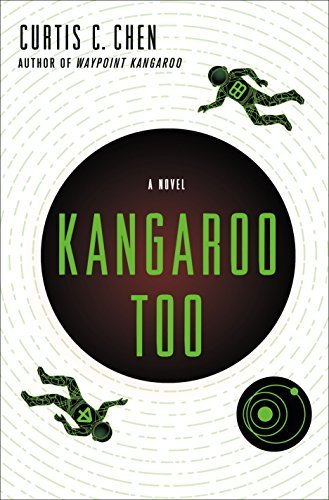A Review of Curtis C. Chen’s Kangaroo Too (Thomas Dunne Books, 2017).
![[personal profile]](https://i.gr-assets.com/images/S/compressed.photo.goodreads.com/hostedimages/1491408111i/22407843.png) lesliejfernandez
lesliejfernandez
A Review of Curtis C. Chen’s Kangaroo Too (Thomas Dunne Books, 2017).
By Stephen Hong Sohn

Like Curtis C. Chen’s debut (Waypoint Kangaroo), I had a number of false starts with this novel. I’m not sure what the problem is because once I did set my mind to finishing this novel, it took off pretty stratospherically, which is to say that this novel (a kind of sequel to Waypoint Kangaroo) improves (significantly) upon Chen’s debut. I mentioned in my review of Waypoint Kangaroo that Chen doesn’t make much use of the main character’s unique power in that novel: his ability to create a kind of pocket in the fabric of space-time, which allows him to store pretty much anything inside, including people and objects. There’s a limit to what he can store in terms of size and in terms of how it impacts him physiologically: the more he uses the pocket and the more massive pocket he creates, the more fatigued he gets. The pocket is obviously metaphorically related to his codename, which connects him to the lovely, bounding titular marsupial. This sort-of-sequel makes much use of this pocket power and is an immensely readable, plot-twisting narrative that never lets up.
We’ll let B&N do some more work here: “Set in the same world as Waypoint Kangaroo, Curtis C. Chen's Kangaroo Too is bursting with adrenaline and intrigue in this unique outer space adventure. On the way home from his latest mission, secret agent Kangaroo’s spacecraft is wrecked by a rogue mining robot. The agency tracks the bot back to the Moon, where a retired asteroid miner—code named ‘Clementine’ —might have information about who’s behind the sabotage. Clementine will only deal with Jessica Chu, Kangaroo’s personal physician and a former military doctor once deployed in the asteroid belt. Kangaroo accompanies Jessica as a courier, smuggling Clementine’s payment of solid gold in the pocket universe that only he can use. What should be a simple infiltration is hindered by the nearly one million tourists celebrating the anniversary of the first Moon landing. And before Kangaroo and Jessica can make contact, Lunar authorities arrest Jessica for the murder of a local worker. Jessica won’t explain why she met the victim in secret or erased security footage that could exonerate her. To make things worse, a sudden terror attack puts the whole Moon under lockdown. Now Kangaroo alone has to get Clementine to talk, clear Jessica’s name, and stop a crooked scheme which threatens to ruin approximately one million vacations. But old secrets are buried on the Moon, and digging up the past will make Kangaroo’s future very complicated...”
This plot description probably gets us to about page 130 in the novel, which means that it leaves the vast bulk of the mystery unspoiled. I’d rather be mum on the matters because there’s a number of surprises, which I had no idea were coming. Sure, there had to be some betrayals and double-crossings, some masquerades at work, precisely because we’re in the Kangaroo world. One of the biggest allies that Kangaroo was supposed to have in the first novel, Sakraida, of course ends up being the super-villain instead. The legacy of Sakraida’s betrayal of Kangaroo’s larger intelligence agency is felt throughout this particular book. Everyone surmises that Sakraida is behind the blast that almost kills Kangaroo in the opening of the novel. At the same time, this particular narrative ratchets up the stakes because the entire lunar colony is put into jeopardy by whatever is going on. Whereas the first novel dealt with a cruise liner in crisis, one that might crash into Mars (if I can vaguely remember correctly), this installment places us on a lunar mission in which tens of millions of lives may depend upon Kangaroo and his allies unraveling the mysteries that continue to crop up here.
In terms of style and atmosphere, Chen obviously retains the comic tonalities of the debut, with Kangaroo’s requisite heterosexual lens filtering pretty much all of his observations. Chen’s self-consciousness about the “hornified” male gaze is apparent when Kangaroo thinks there’s something flirtatious going on with one of the guides who are helping him and Jessica get settled in their affairs on the moon, but what it turns out to be is that this guide is a lesbian and her connection to Kangaroo is simply a sublimation of her desire for a romance that has gone wrong in her own personal life. Kangaroo’s bust here signals a larger conceit concerning his sometimes obscured and certainly subject way of looking at the unfamiliar lunar culture unfolding and catastrophically disintegrating around him. Once I got within the last one hundred pages, there was no choice but for me to stay up until 3 a.m. to finish the novel. To be sure, today, I am cranky, groggy, and unable to do much of what I had hoped to accomplish, but was it worth it? Most definitely yes. Let’s hope Chen has a couple more installments set for us, though as of this time, there’s no mention of a third in the Kangaroo series. Oh, and by way of a quick addition: the title of this novel is especially clever, but what I mean by that, well you’ll just have to read it to understand.
Buy the Book Here:
Review Author: Stephen Hong Sohn
Review Editor: Leslie J. Fernandez
If you have any questions or want us to consider your book for review, please don’t hesitate to contact us via email!
Prof. Stephen Hong Sohn at ssohnucr@gmail.com
Leslie J. Fernandez, PhD Student in English, at lfern010@ucr.edu
 comments
comments



